Massachusetts
Prior to colonisation, Massachusetts was the home of Indian tribes including the Wampanoag, Narragansett, Nauset and Massachusett Indians. European explorers arrived in the early 1600s and were soon followed by fishermen eager to exploit the rich fishing grounds. The local Indian population went into steep decline as a result of diseases such as smallpox, measles and influenza, probably brought by the European fishermen. The initial settlement of Massachusetts was by accident rather than design. In mid July 1620 the Pilgrim Fathers embarked from London on the Mayflower with the intention of settling in Virginia. Their second ship, the Speedwell, proved unseaworthy so they stopped in Plymouth, England to pick up her passengers before setting off across the Atlantic. After a very rough crossing, they sighted Cape Cod on November 9, 1620. They attempted to sail on to Virginia, but heavy seas forced the Mayflower to seek shelter inside Cape Cod. The Pilgrim Fathers explored Cape Cod before deciding to move to the other side of the bay where they settled at Plymouth, a long way from their intended destination. The settlers stayed on the Mayflower over winter, disembarking in March 1621 to start building their settlement. It is the success of their their first harvest that Americans celebrate each November at Thanksgiving. In the 18th century Massachusetts became the birthplace of the American Revolution, which starting in the hinterland around Concord and Lexington where British troops were thin on the ground and dissent flourished.
Massachusetts State House from Boston Common
Travelling around the USA you get used to finding that the capital of a state is often not the largest city, but Massachusetts is not a state that hides its capital away. The Massachusetts State House stands proudly on the slopes of Beacon Hill in Boston, the largest city in the state. Built between 1795 and 1798 this building replaced the old State House that still stands in State Street. The State House name stuck, rather than the post colonial State Capitol. The Massachusetts State House was designed by famous Boston architect Charles Bulfinch who took his inspiration in part from Somerset House in London. The original dome was covered in copper sheet, but in 1861 it was covered with gold leaf. It has been re-gilded several times since, most recently in 1997.
Upper Sheffield Covered Bridge
New England may be famed for covered bridges, but Massachusetts is not the best place to see them. Only six remain and only one of those now dates back to the 19th century. This picture taken in 1985 shows the Upper Sheffield Covered Bridge which then was the oldest covered bridge in Massachusetts built in 1832. It was a 28.7 metre (91 ofot) span Town Lattice bridge across the Housatonic River. In 1994 it was burned down by vandals and was been replaced by a pedestrian-only replica built in 1998.
Old Scituate Lighthouse
Scituate was settled around 1627/8 by a group of people from Plymouth who were joined by new settlers from Kent in England. The name Scituate was derived from the Wampanoag Indian word ‘Satuit’ which means ’cold brook’, referring to a small stream that flowed into the natural harbour. In 1634 Captain John Williams built a farmhouse on the north side of the harbour which he subsequently sold to his grandson, William Barker. The Williams-Barker House still stands albeit now modified into the Barker Tavern. In 1810 the US Congress voted to build a lighthouse at the harbour, and it was completed in 1811 just in time for the War of 1812 with Britain. After the British had burned the fishing boats in the harbour, the two young daughters of the lighthouse keeper foiled a second attack when they spotted troop filled barges and noisily banged a fife and drum. Convinced that there were American troops present, the British retreated. Mariners complained that the original lighthouse could not been seen from very far out, so in 1827 the tower was increased in height. In 1860 a new light was built offshore on Minot’s Ledge, so Scituate Lighthouse was closed and its lantern room removed. In 1930 the Town of Scituate purchased the old lighthouse and built a new lantern room. Old Scituate Lighthouse is now run by the Scituate Historical Society who have relit the light and open it for tours during the summer months.
DLU170918
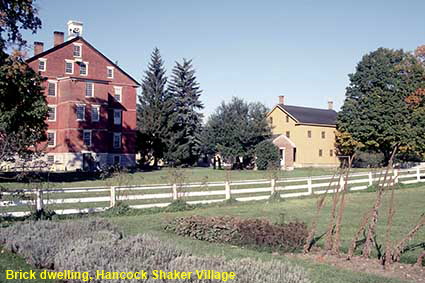
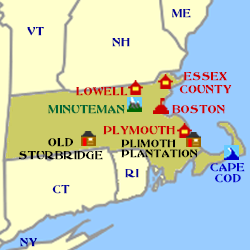
Click on Minimap to navigate
Home > US States > New England >
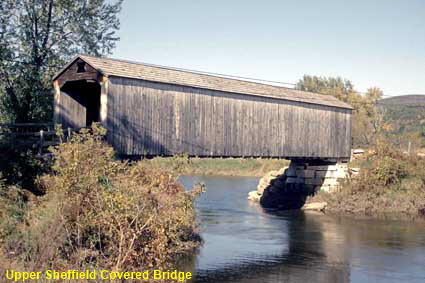
Publick House Inn, Sturbridge
We have stayed in many historic hotels in the USA, but most date from the late 19th or early 20th century, a little young by British standards. In Massachusetts, however, we stayed in a really old hotel, dating back to Colonial times. The first European settler in this area was David Fiske from Stourbridge in England who arrived in 1648 and allegedly spent his first winter sheltering with a wolf family. In time other settlers arrived and heard David’s stories about his life back in Stourbridge. It was not until 1729 that a village was established, and it seems that the stories of Fiske’s home town were still remembered even if the spelling was not. In 1771 Craft’s Tavern opened on the Boston Post Road in Sturbridge. Colonel Ebenezer Craft built it to provide food and lodging for travellers and as a gathering place for villagers. The tavern provided hospitality for some notable visitors including George Washington, Benjamin Franklin, and General Lafayette. It continued in operation until 1923 when Sturbridge went into decline because it had been bypassed by the railroad. It was turned into a boarding house for women called The Elms but this declined due to the depression. Richard Paige acquired the property for $1 as a result of wager in a card game. He decided to restore it as a traditional tavern and called it the Publick House. Today the Publick House Inn is still serving the needs of travellers and locals alike..
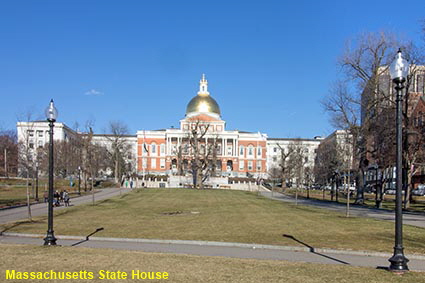


We have more pages on Massachusetts. Click below or on the Minimap:
Brick dwelling, Hancock Shaker Village
In 1747 Jane & James Wardley of Manchester in England set up the Wardley Society, a breakaway group from the Quakers. They adopted an ecstatic form of worship with much trembling and shaking, so they soon became known as the Shaking Quakers or Shakers. Ann Lee joined the society in 1758 and in 1770 she was elected leader. Four years later ‘Mother Ann’ and seven followers left England for America. There as the United Society of Believers in Christ’s Second Appearing they established a communal utopian society. Shakers were celibate so the survival of the movement depended on external recruits. By the early 19th century recruitment had expanded membership to around 4,000 people. Hancock Shaker Village was founded in 1783 and reached its peak in the 1830s with a population of more than 300. The Shakers were famous for their self sufficiency including making their own furniture in a distinctive simple style. In the 20th century the flow of converts slowed. There is still a small active Shaker community in Maine but Hancock closed and in 1960 it became an outdoor history museum. Click Tab 2 for another view with the 1826 Round Stone Barn
Plymouth Rock, Plymouth
Allegedly the Pilgrim Fathers stepped on this rock when they arrived in Plymouth, but it may well be one of the least authentic historical markers in the USA. There is no record of the precise place where they landed, and it was not until 121 years after the Mayflower arrived that anyone claimed to know where they landed. In 1741, 94-year-old church elder Thomas Faunce claimed that his father (who arrived 3 years after the Mayflower) had been assured by several Mayflower passengers that a rock on the shore was the place where they landed. Faunce’s disclosure was apparently triggered by news that the rock was about to be covered by a new wharf. He arranged to be transported down to the harbour to bid the stone goodbye. In 1774, with revolution in the air, the townsfolk decided to retrieve the rock, but while moving it they split it in two. The lower part was left behind while the upper part of the stone was moved to a place in front of their meeting house. Although protected by railings. souvenir hunters started to whittle it down in size. In 1835 buildings were cleared from the wharf to reveal the lower part of the rock and later a canopy was built over it. In 1880 the top of the rock was reunited with the bottom and the date 1620 was carved into it. In 1920 for the 300th anniversary of the landing of the Pilgrim Fathers the whole wharf area was redesigned after which the rock was replaced in its original location but down at the water line. It is now less than half its original size and it is questionable whether it played any part in the arrival of the Pilgrim Fathers. Nevertheless, this rather underwhelming rock receives more than a million visitors each year.
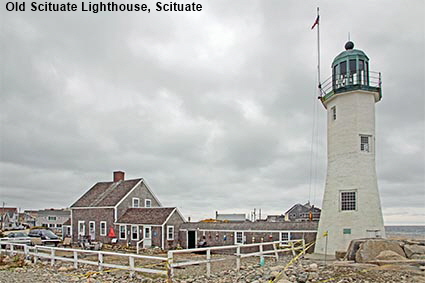
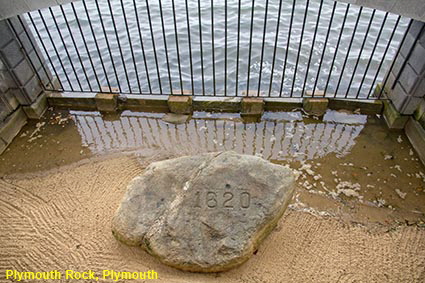
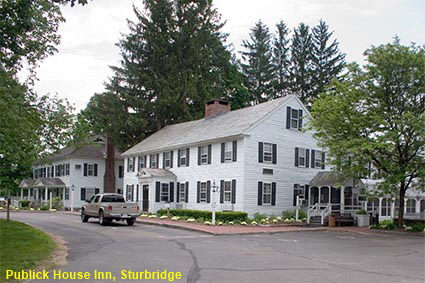

© Mike Elsden 1981 - 2025
The contents of this page may not be reproduced in full or in part without permission